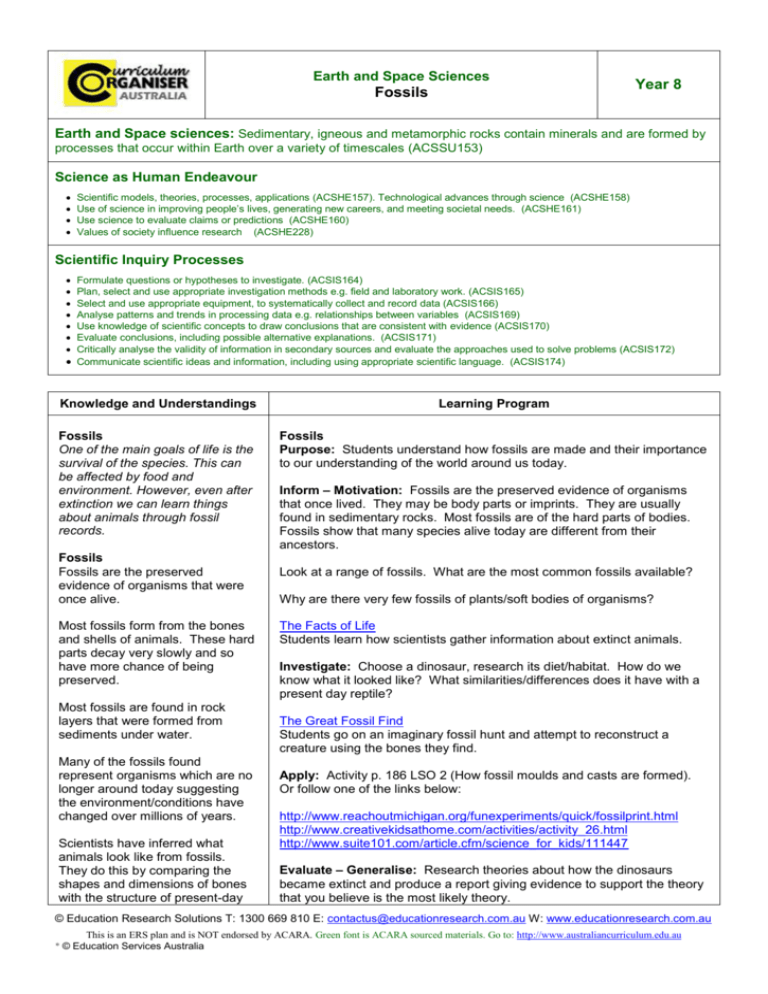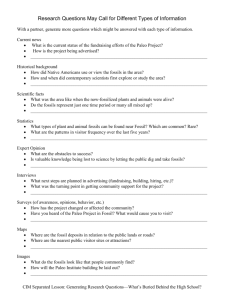Fossils - Goyder.net.au
advertisement

Earth and Space Sciences Fossils Year 8 Earth and Space sciences: Sedimentary, igneous and metamorphic rocks contain minerals and are formed by processes that occur within Earth over a variety of timescales (ACSSU153) Science as Human Endeavour Scientific models, theories, processes, applications (ACSHE157). Technological advances through science (ACSHE158) Use of science in improving people’s lives, generating new careers, and meeting societal needs. (ACSHE161) Use science to evaluate claims or predictions (ACSHE160) Values of society influence research (ACSHE228) Scientific Inquiry Processes Formulate questions or hypotheses to investigate. (ACSIS164) Plan, select and use appropriate investigation methods e.g. field and laboratory work. (ACSIS165) Select and use appropriate equipment, to systematically collect and record data (ACSIS166) Analyse patterns and trends in processing data e.g. relationships between variables (ACSIS169) Use knowledge of scientific concepts to draw conclusions that are consistent with evidence (ACSIS170) Evaluate conclusions, including possible alternative explanations. (ACSIS171) Critically analyse the validity of information in secondary sources and evaluate the approaches used to solve problems (ACSIS172) Communicate scientific ideas and information, including using appropriate scientific language. (ACSIS174) Knowledge and Understandings Learning Program Fossils One of the main goals of life is the survival of the species. This can be affected by food and environment. However, even after extinction we can learn things about animals through fossil records. Fossils Purpose: Students understand how fossils are made and their importance to our understanding of the world around us today. Fossils Fossils are the preserved evidence of organisms that were once alive. Most fossils form from the bones and shells of animals. These hard parts decay very slowly and so have more chance of being preserved. Most fossils are found in rock layers that were formed from sediments under water. Many of the fossils found represent organisms which are no longer around today suggesting the environment/conditions have changed over millions of years. Scientists have inferred what animals look like from fossils. They do this by comparing the shapes and dimensions of bones with the structure of present-day Inform – Motivation: Fossils are the preserved evidence of organisms that once lived. They may be body parts or imprints. They are usually found in sedimentary rocks. Most fossils are of the hard parts of bodies. Fossils show that many species alive today are different from their ancestors. Look at a range of fossils. What are the most common fossils available? Why are there very few fossils of plants/soft bodies of organisms? The Facts of Life Students learn how scientists gather information about extinct animals. Investigate: Choose a dinosaur, research its diet/habitat. How do we know what it looked like? What similarities/differences does it have with a present day reptile? The Great Fossil Find Students go on an imaginary fossil hunt and attempt to reconstruct a creature using the bones they find. Apply: Activity p. 186 LSO 2 (How fossil moulds and casts are formed). Or follow one of the links below: http://www.reachoutmichigan.org/funexperiments/quick/fossilprint.html http://www.creativekidsathome.com/activities/activity_26.html http://www.suite101.com/article.cfm/science_for_kids/111447 Evaluate – Generalise: Research theories about how the dinosaurs became extinct and produce a report giving evidence to support the theory that you believe is the most likely theory. © Education Research Solutions T: 1300 669 810 E: contactus@educationresearch.com.au W: www.educationresearch.com.au This is an ERS plan and is NOT endorsed by ACARA. Green font is ACARA sourced materials. Go to: http://www.australiancurriculum.edu.au * © Education Services Australia animals. L2011 Colossal fossils: the dig Learning Object Education Services Australia The Le@rning Federation Join a team of palaeontologists working on an Australian megafauna dig site. Dig up and describe a megafauna jaw bone or skull. Use tools such as a pick, rock hammer and scraping knife. Prepare the fossil for removal using tools such a fine brush, glue and plaster. See how the features of the bone are used to identify the physical features of the animal it came from. This learning object is one in a series of two learning objects. * http://www.scootle.edu.au/ec/objectLink.action?action=content&id=L2011 Assessment: Produce a fact sheet about a dinosaur Model a fossil Produce a report on theories about why dinosaurs became extinct with supporting evidence. Standards: http://www.australiancurriculum.edu.au/Science/Curriculum/F-10?y=8&s=SU&s=HE&s=IS&layout=1 Teacher Resources IWB T Sustainable Population Australia information that summarises the issue of overpopulation. Living Things In Their Environment ecosystems, habitats, niches, and interactions among living things Student Resources IWB S Fossils & Dinosaurs how fossils are formed. Uncovering The Facts studying dinosaur fossils Fossilisation & Adaptation Activity © Education Research Solutions T: 1300 669 810 E: contactus@educationresearch.com.au W: www.educationresearch.com.au This is an ERS plan and is NOT endorsed by ACARA. Green font is ACARA sourced materials. Go to: http://www.australiancurriculum.edu.au * © Education Services Australia Lesson Planner Lesson Teacher Notes Student Activities Resources Title: 1 Date Time Title: 2 Date Time Title: 3 Date Time Title: 4 Date Time Title: 5 Date Time © Education Research Solutions T: 1300 669 810 E: contactus@educationresearch.com.au W: www.educationresearch.com.au This is an ERS plan and is NOT endorsed by ACARA. Green font is ACARA sourced materials. Go to: http://www.australiancurriculum.edu.au * © Education Services Australia






